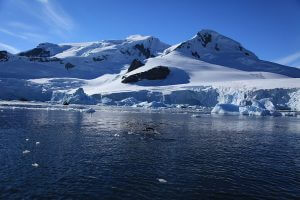
A recent Nature publication from a large team of scientists in Europe, Canada, and the US reports the use of SMRT Sequencing to elucidate the genome of Fragilariopsis cylindrus, a single-celled eukaryotic diatom adapted to living in polar waters of the Antarctic Ocean. The work has implications for the biotechnology industry, which looks to extremophiles as a potential source of important enzymes.
“Evolutionary genomics of the cold-adapted diatom Fragilariopsis cylindrus” comes from lead author Thomas Mock, senior author Igor Grigoriev, and many collaborators at the University of East Anglia, Earlham Institute, Joint Genome Institute, University of California, Berkeley, and several other organizations. The project investigated how this diatom evolved to thrive in its extreme environment, frequently living in high salinity directly under sea ice.
To achieve this, the team started by sequencing the F. cylindrus genome using both Sanger and PacBio systems. For SMRT Sequencing, the scientists produced two libraries with different insert sizes (4 kb and 20 kb) and ran seven SMRT cells, which yielded 63-fold coverage of the genome. The team used the diploid-aware FALCON assembler, which generated a 59.7 Mb assembly with 745 primary contigs. In an analysis and comparison to the Sanger assembly, the scientists determined the PacBio assembly was highly accurate in sequence (ranging from 99.65% to 100%) and structure (through validation fosmid comparison).
F. cylindrus is characterized by highly divergent alleles, which represent nearly a quarter of its genome. An analysis of those genes determined that the “divergent alleles were differentially expressed across environmental conditions, including darkness, low iron, freezing, elevated temperature and increased CO2,” the scientists report. “Alleles with the largest ratio of non-synonymous to synonymous nucleotide substitutions also show the most pronounced condition-dependent expression, suggesting a correlation between diversifying selection and allelic differentiation.” The team hypothesized that allele diversification took place after the last glacial period and has been maintained because the variety of gene content allows for rapid adaptation to a changing environment.
The Earlham Institute issued a press release about the project, including this comment from scientist Pirita Paajanen: “This is the first time at EI that a genome of this type was assembled into chromosomes. It is only very recently that the technology has been developed to cope with such a highly heterozygous organism and the data show that this diatom does actually have a large amount of variation within their genes.”
